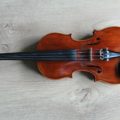Beginners often groan and roll their eyes as they begin to learn violin scales. However, there is a method to what seems to be a repetitive task. Understanding the violin scales is like learning the alphabet before you learn to read. Knowing how the letters sound and some of the basic rules make understanding how to read a sentence, then a paragraph, then many pages so much easier. It is much the same with learning how to play the violin Play the Violin - A Whole Novice's Guide - The violin, also known as a fiddle, is a bowed string instrument. It has four strings that are tuned in perfect fifths. The violin is the smallest and highest pitched member of the string instrument family, which also includes violas and cellos. Although playing the violin can be quite challenging, when mastered, it produces a… scales. Once you have mastered the basic scales, you can play many beginner pieces set in one of those major G or A scales.
One tried and true method is to start with the G scale. This simply means you start with the G string in an open sound, running the bow back and forth over the string without putting pressure from your fingers on the string. Each scale usually comprises three octaves. Octave comes from the Latin root for eight (oct) as in octagon, which is an eight-shaped figure, or octopus, which has eight legs. The octave has the A, B, C, D, E, F, G notes and then repeats one of those letters. So in the G scale, you start with an open G, then play A-F and end with G going up in pitch.
The G scale is the easiest for three reasons. It is the first string on the violin, and it is the easiest to learn to play as far as your finger positions. Plus, the fact that there is only one sharp (#) note in this scale makes it easier for the beginning violin student to play. It starts with an open note, which gives you time to place your fingers for the next notes. Then you move up in pitch for two more octaves.
At first, you may feel awkward, but if you keep practicing, your brain will begin to register how to tell your fingers to place pressure on what strings and when. Soon, your ears and fingers will learn what each note in the scale is supposed to sound and feel like. Don’t give up. It will happen.
The next of the violin scales is the D scale, which has a similar finger position. The difference is that it has two sharp notes, not just one as the G scale did. It is called a D scale because that is the note with which you begin the octave sequence – D, then E, F, A, B, C, and back to a higher D. You will do this for three octaves, just as you did before with the G scale.
By now, you are noticing a pattern. You are moving along the four strings, G, D, A, E. The A scale is obviously next, and follows the alphabet, ending again with A. The reason it is not the first scale you learn is that the A scale now has three sharp notes. As you learn the basic major scales, the number of sharp notes is increasing.
Finally, you reach the E scale with, yes – you got it, four sharp notes. By the time you reach this scale, you’ll already feel a great deal more comfortable in playing the violin Violin Exercises For a Masterful Performance - Playing the violin undoubtedly requires exceptional skill, a keen ear for music, and remarkable concentration to enable the violinist to produce the exquisite melodies characteristic of a flawlessly executed violin piece. The sound produced by a violin is distinct, setting it apart from all other instruments in an orchestra, and entirely different from its fellow… scales as a whole. Your fingers are beginning to land right where they need to be, and you are actually sounding pretty good – almost like a real violin player!
Manuel Marino is a seasoned Senior Producer, Music Composer, and Artist with over a decade of experience. He specializes in branded entertainment across various mediums, including video games, films, and advertising campaigns. With 20+ years as a game music composer, Manuel has worked on numerous platforms, creating diverse orchestral soundtracks. HIRE ME


 Manuel is a passionate, driven, and techsavvy AV technician,
Manuel is a passionate, driven, and techsavvy AV technician, 



